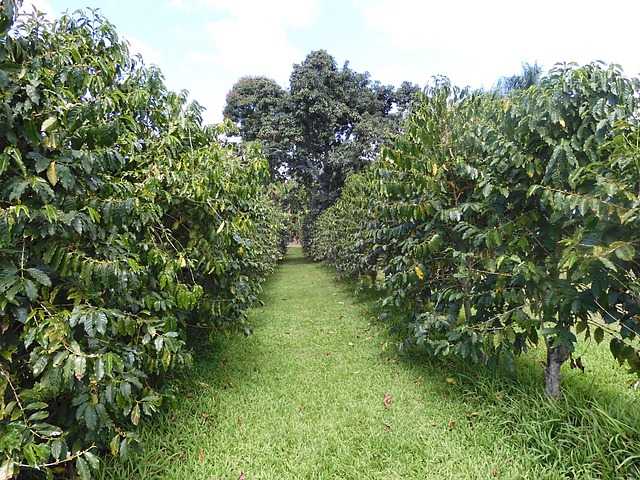HOLUALOA, HAWAII, USA – Kona coffee farmers are facing big challenges this year. In a recent e-mail to members, industry group Kona Coffee Farmers Association (KFCA) reported that the “Hawaiʻi coffee industry is bracing for what could be one of their worst years for production. That will likely mean higher prices for coffee drinkers as well.”
For the 2022/2023 harvest season, Kona coffee yields are anticipated to precipitously drop by as much as 30% -40%. What key factors are contributing to this decrease?
CBB (Coffee Berry Borer Beetle):
This destructive pest has wreaked havoc on Kona coffee farms for years. Originally from Africa, but also prevalent in other coffee-producing regions in Central and South America, the detrimental beetle arrived on the Big Island in 2010. As the Hawaii Department of Agriculture (HDOA) explains, “The beetle bores into the coffee cherry to lay its eggs. The larvae feed on the coffee bean and because the larvae are inside the bean, it makes it difficult to control by pesticides.”
The Kona Coffee Farmers Association (KFCA) reports that, “CBB has been found on all major Kona coffee farms.” And the problem is only getting worse. In a recent study conducted by the University of Hawaii at Mānoa, it was discovered that “the number of CBB-infested coffee trees nearly tripled from 2012 to 2018.”
Damage caused by CBB directly impacts Kona coffee bean quality, contributing to lower yields and higher levels of defects. This makes the coffee bean less valuable. If a coffee farm has a high infestation rate, it can be disastrous for the grower.
CLR (Coffee Leaf Rust)
Another challenge confronting Kona coffee farmers is CLR or Coffee Leaf Rust. It first appeared in Kona in 2020. CLR is a fungus that attacks coffee plants and can cause major losses in yield and crop quality. As stated on the HDOA website, “CLR can cause severe defoliation of coffee plants. Infected leaves drop prematurely, greatly reducing the plant’s photosynthetic capacity. Vegetative and berry growth are reduced depending on the intensity of rust in the current year.”
In order to combat CLR, many farmers stumped their trees in an attempt to “reboot” their orchards. But stumped trees don’t produce coffee and can take years to return to a full yield, a heavy price to pay for Kona coffee farmers faced with this dilemma.
Climate Change
Kona coffee farmers are also contending with the effects of climate change. The Goldilocks conditions that make the Kona coffee belt ideal for growing exceptional coffee are naturally susceptible to fluctuations in temperature and moisture. Many coffee farms in Kona faced hotter temperatures and drought conditions which brought about an earlier harvest. “We’re struggling a bit with it on all ends”, commented KCFA President Suzanne Shriner in a recent e-mailed report to members. “In a normal year, we’d start harvesting in late August or early September, but nothing is normal anymore with the weather patterns. Everything is moving around on us. It’s been a problem.”
Increased Costs
As in other parts of the economy, Kona coffee farmers are facing increased costs for everything from fuel to farm equipment. Living on an island necessitates shipping supplies in and out, with those costs rising at every turn as well. Kona coffee farmers are being squeezed from all sides. They are struggling to keep their farms afloat and maintain the high standards that are expected of this world-class, Hawaiian specialty coffee.
Like so many other Kona coffee growers, Kona Earth, a family-owned farm in Holualoa, is feeling the effects of these problems. Husband and wife team Steve and Joanie Wynn took the reins of the farm recently and are experiencing the uncertainty alongside their fellow Kona coffee farmers. Owner Steve Wynn commented, “Kona coffee farming is incredibly rewarding but, at the same time, these challenges are making it tough on our bottom line.” Still, he is optimistic. “Luckily, our farm is situated at 2200 feet, so at least we haven’t faced the drought conditions plaguing some other farms.”
What Impact Will This Have?
Kona coffee is an important agricultural product for the state of Hawaii. According to the Hawaii Coffee Association (HCA), “For the 2019-2020 season, Hawaii’s unroasted coffee was valued at $102.91 million (ii), while its roasted value was more than (iii) $148.48 million.” The anticipated decrease in yield for the upcoming harvest will have a ripple effect, impacting not only growers but associated businesses that partner with Kona coffee farmers. From green buyers and roasters to restaurants and retail stores, the impacts will be felt throughout the state of Hawaii.
The HCA has also stated, “Kona coffee is one of the world’s most famous and expensive coffees. It is grown only in the North and South Kona districts on the Big Island of Hawaii.” This limited production, combined with the fact that Kona coffee trees take up to five years to mature, means that the decrease in yield will be keenly felt by growers. Many of them are small family businesses that rely on the revenue from coffee sales to support themselves.
The decrease in yield is also likely to have an impact on the price of Kona coffee. At present, a pound of roasted Kona coffee beans retails for around $50. If the supply of Kona coffee decreases, it is likely that the price will increase, making it even more expensive. This could make it inaccessible for many people who enjoy drinking Kona coffee.
It is clear that the decrease in Kona coffee yield will have far-reaching consequences for the state of Hawaii. The impact will be felt by growers, businesses, and consumers alike. It is important that everyone works together to support the Kona coffee industry during this difficult time.
The Kona coffee farmers are in for a tough few years. But with the support of organizations like KFCA, HCA, and HDOA, as well as the loyalty of Kona coffee drinkers, they will weather this storm.

















